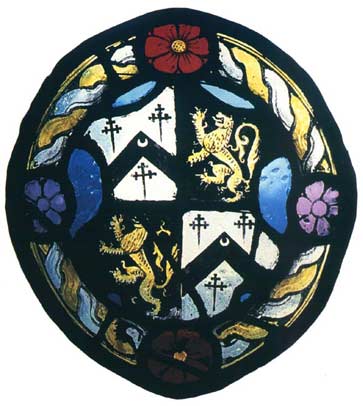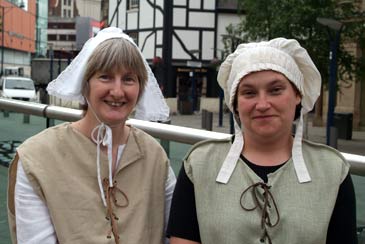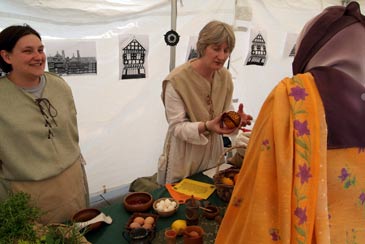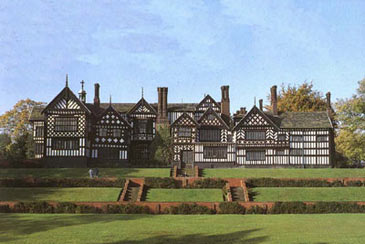
The Elizabethan Age 1558 - 1603 AD
History
The Tudor period (which included the Elizabethan Age) is characterised primarily by the marital exploits of Henry VIII. He is famous for having had 6 wives, and for creating the Church of England in order for him to divorce his first wife, Catherine of Aragon. Failure to produce a male heir could result in a royal wife meeting a sticky end - two wives were beheaded.
The religious change did not stop here – Henry’s son Edward VI continued to keep England Protestant, but Mary I, his sister and successor, attempted to return the country to Catholicism. It was confusing for people – not to mention dangerous. She wasn’t known as Bloody Mary for nothing!
Calmness returned with the succession of Elizabeth I, whom, although a Protestant realised the wisdom of allowing people to quietly practice the catholic religion if they wished. Elizabeth was an extremely strong monarch who fought hard to be considered the equal of any man. She never married, but rumours were rife about her supposed affair with Robert Dudley – whose wife died in rather strange circumstances. Elizabeth died in 1603, thus ending the Tudor Age.
For the rich in Tudor times it was a period of opulence – much feasting and hunting. The New World was being discovered and many new and exciting things were coming into the country. Unfortunately if you were a poor Tudor your life was hard. Minor “offences” were punished in horrific ways, there was no medicine so invariably people died very young, and there were no opportunities to improve your lot.

Bramall Hall Coat of Arms
Death, Disease and Destruction
The Bubonic plague (Black Death) was the greatest fear of people living during the Elizabethan era from the Queen herself to the lowliest of her subjects.
During the period there were repeated outbreaks of the Plague, and these were not just confined to highly populated towns such as London. The country area and villages were not exempt from the disease either - there was no hiding place.
In the late sixteenth and seventeenth centuries victims of Black Death would be sealed in their houses. The houses would be locked and bolted from the outside. The victims were not allowed to leave and neither was anyone else allowed to enter. This action was tantamount to signing a death warrant for the whole family and one of the terrible consequences of the disease. Any victim of the Bubonic Plague or Black Death would have to obtain a ' Certificate of Health ' to resume normal life - if they recovered...
The symptoms associated with the disease were, and are, painful swellings (bubos) of the lymph nodes. These swellings would appear in the armpits, legs, neck, or groin. Victims also suffered a very high fever, delirium, vomiting, muscular pains, bleeding in the lungs and mental disorientation. The illness also produced in the victim an intense desire to sleep, which, if yielded to, quickly proved fatal. Victims usually died within 3 or 4 days of the first symptoms.
Will I Have Heard of Any Famous Elizabethans?
- William Shakespeare
- Francis Drake
- Francis Bacon
- Walter Raleigh
- Christopher Marlowe
Can You Give Me a Famous Quote From the Time?
There are some common sayings we use today that have their origins in Elizabethan Times. The “sleep tight” part of “Night night, sleep tight and don’t let the bed bugs bite” refers to the fact that the base of beds were made of ropes strung together. As the nights passed those ropes would get loose and it was the servant’s job to tighten them to ensure a good night’s sleep. The bed bugs biting were a fact of Elizabethan life!
Being referred to as “straight laced” harks back to the time when ladies bodices were laced up, before zips and Velcro. Ladies who were of ill repute laced their bodices as we would lace our shoes – criss-crossed. This apparently made it easier to get out of in a hurry! Straight lacing was much harder to undo!
Quiz Questions
- Which country suffered a big defeat at the hands of Elizabeth's navy in 1588?
- What was the name of the ship that Sir Francis Drake circumnavigated the world on?
- Which everyday vegetable was first introduced to England in Elizabethan times?
You can find the answers here…

What Was the Food Like?
Lob Lolly
- Cover 4 ounces of rice with water and soak overnight.
- Boil the rice with 4 pints of water until much of the water is absorbed.
- Add a lump of butter salt and sugar until the dish is “indifferently sweet”.
Alternatively the rice can be soaked and boiled as before until a “spoon may stand upright in it, and no liquidnesse of the water perceived.” Then add a large lump of butter and stir around while it “boils”. This may produce either buttered or fried rice depending on how the original recipe is interpreted. Season with a little sugar and cinnamon.
Jumbles or Knotted Biscuits
2 Eggs
100g sugar
15ml (1 tbls) aniseed or caraway
175g plain flour
- Beat the eggs in a basin then beat in the sugar, the aniseed or caraway, and finally the flour, thus forming a stiff dough.
- Knead the dough on a lightly floured board, and form into rolls approximately 1 cm in diameter and 10 cm in length. Tie each of these in a simple knot and plunge them, five or six at a time, into boiling water, where they will immediately sink to the bottom.
- After a short time dislodge the knots from the bottom of the pan with a spoon so they float and swell for a minute or two. The lift the knots out with a perforated spoon, and allow them to drain on a clean tea towel laid over a wire rack.
- Arrange the knots on a lightly buttered baking sheet and bake for 15 minutes at gas mark 4, 180ºc, then turn the knots over and return to the oven for 10-15 minutes until golden.
Jellief Milk
25 ml (5 5sp) gelatine
575ml (1 pint) milk
100g (4oz) sugar
25ml (5 tsp) rosewater
- Sprinkle gelatine on 60ml (4 tbsp) milk in a cup.
- Leave 5 mins then stand cup in hot water and stir till gelatine dissolves.
- Warm remaining milk, stir in gelatine and sugar, and simmering stir continuously for 5 mins.
- Remove from heat , stir in rosewater and pour in shallow baking dish, 6” square, which has been freshly rinsed in cold water.
- Allow to set in a cool place till firm then cut in squares.

Thick Pea Pottage (a thick soup or a side vegetable)
1oz fresh breadcrumbs
1 egg yolk
1 tsp chopped parsley
1 tsp salt
½ tsp ground ginger
Pinch saffron
½ pint milk
12 oz cooked peas or 19oz can of peas
- Beat breadcrumbs, yolk, parsley, salt, ginger and saffron together.
- Heat milk to almost boiling and pour in peas and breadcrumb mixture, then bring to boil over a low heat stirring continuously.
- How long you boil it depends on how thick it becomes - so it is either a soup or a side dish.
To Stewe Stekes Of Mutton
2 lb leg of lamb or mutton (this recipe also works well with beef)
1 pint dark beer or ale
2 onions, thinly sliced
1 tsp salt
Pepper to taste
2 Tbsp butter
- Bone the lamb, trimming off any skin or excess fat.
- Cut into thin slices across the grain.
- Place in a heavy pan with the beer and onions, cover and simmer for an hour.
- Add the salt, pepper and butter and continue simmering for 30 minutes, or until tender.
- Though it's not in the recipe, I've found that adding 1/2 tsp or so of malt vinegar or cider vinegar really sparks up the dish.
- Serve with fingers of fried bread.
Almond Pudding
15 fl oz/450 ml milk
5 fl oz/150 ml double cream
2 oz/50g fresh white breadcrumbs
3 oz/75g caster sugar
6 oz/175g ground almonds
1 tsp rose or orange flower water
3 eggs
1 oz/25g butter
- Warm milk and cream and pour over the breadcrumbs in a bowl.
- Stir in the sugar, ground almonds and rose or orange water and leave to soak for 15 mins.
- Beat the eggs and blend thoroughly with the breadcrumb mixture.
- Pour into a 2 pint/1 litre buttered pie dish and dot with butter.
- Place the dish in a roasting tin filled with enough hot water to come halfway up the sides of the dish.
- Bake in oven gas 4/180oc for 30 mins or till pudding is just set.
- Serve hot.
Lemon Or Lime Posset
zest & juice of 2 lemons or limes
1 pint/600 ml double cream
5 fl oz/150 ml dry white wine
2-3 tbsp caster sugar
3 large egg whites
- Whisk cream and zest together in a large bowl till stiff.
- Gradually stir in the wine and fruit juice, then add sugar to taste.
- Whisk egg whites till they form stiff peaks, then fold into cream mixture.
- Chill then serve.
What Did the Elizabethans Do in Manchester?
To be honest, nothing much happened in Manchester during Elizabethan or Tudor times. Manchester wasn't even involved in the Wars of the Roses (despite being ideally placed between Lancashire and Yorkshire!). However, Henry VII passed through on his way to visit his mother, making him the first reigning monarch to visit Manchester!
What Did Things Look Like in Elizabethan Times?

How Will the Period be Represented at the 7 Ages of Manchester?
At the Festival, Bramall Hall staff will be demonstrating many aspects of daily life in Elizabethan Manchester. There will be an opportunity for visitors to have a go at producing their own piece of wattle and daub – the materials used to in-fill timber framed buildings – along with a look at how the timber frame itself was put together.
Visitors will also be able to learn about traditional food from the period, and there will be examples of such food for people to see (though not try – there will be recipes for people to take home and try out themselves if they wish). In addition to this people will be able to make marzipan chess pieces, which might have been used to decorate a high table at somewhere like Bramall Hall. There will be demonstrations of Tudor songs and dances by local school children.
Where Can I Find Out More About the Elizabethan Age?
There are many Elizabethan houses in the local area, including Ordsell Hall in Salford and Little Moreton Hall near Congleton.
Bramall Hall
Find more information here,
or alternatively
www.bramallhall.org.uk
Quiz Answers
- Spain
- Golden Hind
- Potato
